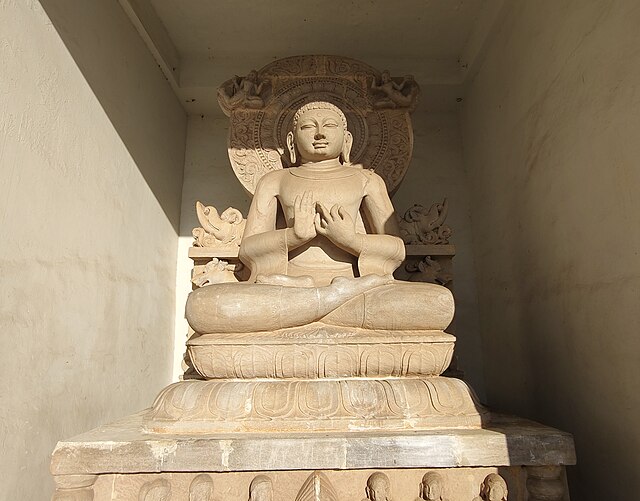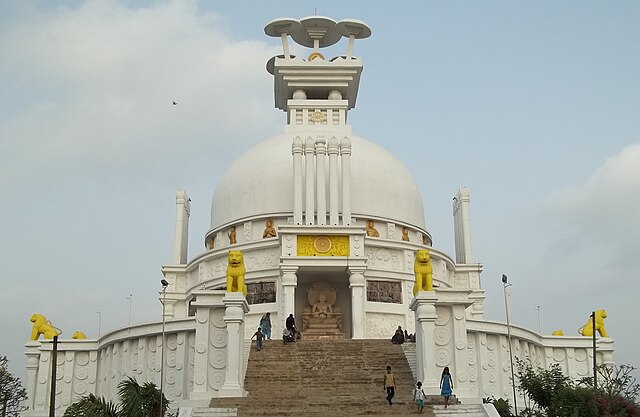Have you ever wondered what it feels like to stand where history was made? Where an emperor’s heart changed forever, and the course of an entire civilization shifted? Welcome to Dhauli, a sacred hill just 8 kilometers from Bhubaneswar that holds secrets dating back over 2,000 years.
The Sacred Hill That Changed an Emperor’s Heart
Picture this: you’re standing on a gentle hill overlooking the Daya River, and the wind carries whispers of ancient battles and profound transformations. This isn’t just any hill – this is Dhauli, where one of history’s most powerful rulers experienced a change of heart so profound that it echoed through centuries.
Dhauli isn’t just a tourist destination; it’s a pilgrimage site for history buffs, spiritual seekers, and anyone who appreciates the power of transformation. But what makes this place so special? Let’s dive into the fascinating story that unfolds on this sacred ground.
Historical Significance of Dhauli
The Kalinga War: A Turning Point in History
Around 261 BCE, the banks of the Daya River witnessed one of the bloodiest battles in ancient Indian history. Emperor Ashoka, known for his military prowess and territorial ambitions, waged war against the kingdom of Kalinga (modern-day Odisha). The Kalinga War wasn’t just another conquest – it was a brutal conflict that left over 100,000 soldiers dead and 150,000 people displaced.
Can you imagine the magnitude of destruction? The battlefield was so soaked in blood that the Daya River reportedly ran red. This wasn’t just a victory for Ashoka; it was a pyrrhic triumph that would haunt him forever.
Emperor Ashoka’s Transformation
Here’s where the story takes an extraordinary turn. Standing on the same hill where you might visit today, Emperor Ashoka surveyed the aftermath of his victory. Instead of feeling triumphant, he was overwhelmed by remorse and guilt. The sight of countless dead bodies and the cries of the wounded pierced through his warrior’s heart like nothing ever had before.
This moment of profound realization transformed Ashoka from a ruthless conqueror into one of history’s most compassionate rulers. He embraced Buddhism and dedicated his life to spreading the message of peace, non-violence, and dharma. Isn’t it amazing how one moment of clarity can change not just a person, but the entire trajectory of history?
The Famous Rock Edicts of Dhauli
What Makes Dhauli’s Edicts Special?
When you visit Dhauli today, you’ll encounter something truly remarkable – rock edicts carved directly into the hillside. These aren’t just ancient graffiti; they’re some of the oldest surviving royal proclamations in India, dating back to the 3rd century BCE.
The Dhauli rock edicts are particularly special because they contain the separate Kalinga edicts – messages specifically addressed to the people of Kalinga. These edicts reflect Ashoka’s remorse over the war and his commitment to ruling with compassion rather than force. It’s like reading a personal apology letter from an emperor to his people, carved in stone for eternity.
The Language and Message of Peace
Written in the ancient Brahmi script and Prakrit language, these edicts carry messages of tolerance, non-violence, and administrative efficiency. Ashoka didn’t just say sorry; he outlined practical policies for good governance. He spoke about treating subjects like his own children, promoting religious tolerance, and ensuring justice for all.
What’s fascinating is how personal these messages feel. You can almost hear Ashoka’s voice speaking directly to the people, promising them a better future. These aren’t just historical documents; they’re humanity’s earliest examples of public relations and political accountability.
Dhauli Shanti Stupa: A Monument to Peace

Architecture and Design of the Peace Pagoda
Fast forward to 1972, and Dhauli gained another jewel – the Shanti Stupa or Peace Pagoda. This brilliant white structure stands like a beacon of peace against the blue sky, visible for miles around. But this isn’t just beautiful architecture; it’s a symbol of international cooperation and shared spiritual values.
The stupa follows traditional Buddhist architecture with a hemispherical dome crowned by a harmika and topped with an umbrella-like structure called a chattravali. The white marble gleams in the sunlight, creating an almost ethereal atmosphere that perfectly complements the hill’s spiritual significance.
The Japanese Connection
Here’s something you might not know – the Dhauli Shanti Stupa was built as a joint project between India and Japan. The Japan Buddha Sangha and the Kalinga Nippon Buddha Sangha collaborated to create this monument as a symbol of peace and friendship between the two nations.
This collaboration makes perfect sense when you think about it. Both countries understand the devastating effects of war and the precious value of peace. The stupa stands as a testament to the universal human desire for harmony and understanding, transcending national boundaries.
Spiritual Significance and Buddhism
Dhauli holds immense significance in Buddhist tradition, not just because of Ashoka’s conversion, but because it represents the triumph of compassion over violence. The hill has become a pilgrimage site for Buddhists from around the world who come to meditate and reflect on the teachings of peace and non-violence.
The energy here is palpable. Whether you’re religious or not, there’s something profoundly moving about standing where such a monumental transformation took place. It’s like visiting the birthplace of compassion in governance – a concept that seems more relevant today than ever before.
Modern-Day Dhauli: A Tourist Paradise
Best Time to Visit Dhauli
Timing your visit to Dhauli can make all the difference in your experience. The best time to visit is during the winter months from October to March when the weather is pleasant and comfortable for exploration. The monsoon season (June to September) brings lush greenery but can make the pathways slippery.
If you’re planning to attend the famous Dhauli Kalinga Mahotsav, mark your calendar for December. The festival usually takes place in the first week of December, transforming the peaceful hill into a vibrant cultural hub.
How to Reach Dhauli from Bhubaneswar
Getting to Dhauli is surprisingly easy. Located just 8 kilometers south of Bhubaneswar on the Bhubaneswar-Puri highway, it’s perfectly positioned for a day trip. You can hire a taxi, take a bus, or even drive yourself – the roads are well-maintained and the journey takes about 20-30 minutes from the city center.
The approach to Dhauli is scenic, with the road winding gently uphill through green landscapes. As you near the site, the white dome of the Shanti Stupa comes into view, creating a sense of anticipation and reverence.
What to Expect During Your Visit
Your Dhauli experience begins with a gentle climb up the hill. Don’t worry – it’s not strenuous, and there are proper pathways and steps leading to the main attractions. The first thing that strikes most visitors is the serenity of the place. Despite being a popular tourist destination, Dhauli maintains a peaceful, contemplative atmosphere.
You’ll want to spend time at the rock edicts, trying to decipher the ancient script and imagining Ashoka’s craftsmen carefully carving these messages into stone. The Shanti Stupa offers panoramic views of the surrounding countryside and the Daya River valley. Many visitors find themselves sitting quietly, simply absorbing the historical significance of their surroundings.
Dhauli Kalinga Mahotsav: Cultural Extravaganza
The Festival That Brings History Alive
Every December, Dhauli transforms from a quiet historical site into a vibrant celebration of art, culture, and peace. The Dhauli Kalinga Mahotsav is a three-day festival that brings together artists, performers, and visitors from across India and beyond.
What makes this festival special is how it connects past and present. Against the backdrop of ancient rock edicts and the modern Peace Pagoda, you’ll witness classical dance performances, folk music, craft exhibitions, and cultural programs that celebrate Odisha’s rich heritage while promoting Ashoka’s message of peace and non-violence.
The festival isn’t just entertainment; it’s education in the most enjoyable form. You’ll learn about local traditions, sample authentic Odishan cuisine, and participate in workshops that keep ancient arts alive. It’s like attending a history class that’s been transformed into a celebration.
Photography and Scenic Beauty
Dhauli is a photographer’s dream, offering countless opportunities for stunning shots. The contrast between the white marble stupa and the blue sky creates picture-perfect moments, especially during sunrise and sunset. The panoramic views from the hilltop encompass the meandering Daya River, lush paddy fields, and distant hills.
The rock edicts provide fascinating close-up subjects, with their ancient script telling stories across millennia. During the monsoon and post-monsoon seasons, the surrounding landscape turns emerald green, creating a beautiful backdrop for the historical monuments.
Professional photographers and Instagram enthusiasts alike will find endless inspiration here. The changing light throughout the day offers different moods and atmospheres, from the soft golden hour glow to the dramatic shadows of midday.
Nearby Attractions and Day Trip Ideas
Dhauli’s strategic location makes it perfect for combining with other attractions in a full day of exploration. The famous Pipili appliqué craft village is just a short drive away, where you can witness artisans creating colorful traditional handicrafts that Odisha is famous for.
Nandankanan Zoological Park, one of India’s premier zoos and botanical gardens, is about 30 kilometers from Dhauli. If you’re interested in temples, the ancient Rajarani Temple and the magnificent Lingaraj Temple in Bhubaneswar are must-visits that complement the historical experience of Dhauli.
For those interested in extending their spiritual journey, the Udayagiri and Khandagiri caves, with their Jain heritage dating back to the 2nd century BCE, offer another fascinating glimpse into ancient Odisha’s religious diversity.
Conclusion
Dhauli stands as more than just a historical site – it’s a testament to the power of transformation and the enduring appeal of peace over conflict. From the bloodiest battlefield to a symbol of non-violence, this sacred hill embodies humanity’s capacity for change and growth.
Whether you’re drawn by history, spirituality, or simply the beauty of the place, Dhauli offers something profound to every visitor. It reminds us that even in our modern world, the ancient values of compassion, tolerance, and peaceful coexistence remain as relevant as ever.
As you plan your visit to this remarkable place, remember that you’re not just seeing tourist attractions – you’re walking in the footsteps of one of history’s greatest transformations. In a world that often seems divided, Dhauli’s message of peace and understanding resonates more powerfully than ever before.
Frequently Asked Questions (FAQs)
1. What is the historical significance of Dhauli?
Dhauli is the site of the famous Kalinga War (261 BCE) where Emperor Ashoka’s transformation from a ruthless conqueror to a compassionate ruler took place. It houses ancient rock edicts that represent some of India’s oldest royal proclamations and marks the birthplace of Ashoka’s adoption of Buddhism and non-violence.
2. How long does it take to explore Dhauli completely?
A typical visit to Dhauli takes about 2-3 hours to explore the rock edicts, Shanti Stupa, and enjoy the panoramic views. If you’re visiting during the Kalinga Mahotsav festival, you might want to spend a full day to enjoy the cultural performances and exhibitions.
3. Is Dhauli suitable for children and elderly visitors?
Yes, Dhauli is family-friendly with well-maintained pathways and gentle slopes. While there is some walking involved to reach the main attractions, the paths are not too strenuous. However, elderly visitors or those with mobility issues should wear comfortable shoes and take their time climbing the hill.
4. What should I wear when visiting Dhauli?
Comfortable walking shoes are essential as you’ll be climbing gentle slopes and walking on stone pathways. Dress modestly and respectfully, as it’s a site of religious and historical significance. During summer months, carry sun protection, and in winter, light layers are recommended.
5. Can I hire a guide at Dhauli?
Yes, local guides are available at Dhauli who can provide detailed information about the historical significance, explain the rock edicts, and share interesting stories about Emperor Ashoka’s transformation. Hiring a guide can greatly enhance your understanding and appreciation of the site’s importance.

